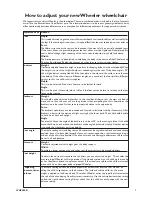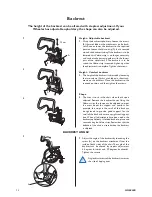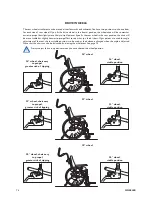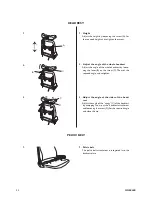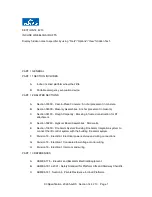
6
WHEELER
7
WHEELER
Adjustment of Reason
Seat Depth
This is to be adjusted to give the user sufficient seat depth to sit comfortably, as well as stability for
the legs. If the seat depth is too short, it may be difficult for the user to keep his or her balance.
Form
The Velcro strips under the seat can be loosened if you want a fully or partially rounded form.
If the user’s knees are pressed together, the seat cover must be tightened. A completely flat
seat is best, although slight rounding of the seat under the bottom may help for balance.
Width
The hip supports are to be adjusted to help keep the body in the centre of the Wheeler chair.
They can be widened if body size changes or when the user wears thicker clothes.
Footrest
Height
Correctly adjusted foot plate height is important for keeping balance in the whole body. When
the height is correct, the thighs should rest relaxed against the seat. If the knee angle is 90º,
this will give better seating stability. If the foot plate is too close to the castors, raise the seat
(see below). If the child’s legs are different lengths, you can adjust the foot plate to different
heights, so that the child can sit straighter.
Depth
This is to be adjusted if the user’s feet are to be further forward.
Angle
This is to be used if the ankle joint is stiff or if the foot cannot be level in relation to the seat
for any other reason.
Backrest Height
This should not be adjusted higher than to the shoulder blades so that the arms are free to
move and so that the user can use long strokes when propelling the chair. Sometimes the
backrest must be raised further to help maintain balance in the upper body.
Form
The backrest upholstery can be rounded and formed to facilitate stability if necessary. A flat
backrest is best with the option of slight curving by the lower back. The child should be able
to hold his or her head upright.
Angle
For most children, the angle of the backrest is to be at 90º to the seating surface. If the child
cannot hold up his or her head, the backrest can be angled backwards slightly. Another option
is to angle the whole seat unit (see below).
Seat angle
The whole seating unit, including seat and backrest, can be angled to achieve a relaxed seating
position. It can also be angled forwards for an active seating position, that facilitates getting in
and out of the chair, for example. If the chair has mechanic seat angle adjustment, the seat can
be set in a fixed position.
Armrest
Height
Correctly adjusted armrest height gives the body support.
Width
To achieve a larger seating area and wider seat, the armrests can be moved sideways.
Seat height
To obtain the correct distance to the handrims, you can adjust the height. This enables the
user to propel Wheeler with large strokes. If the wheels are too high, the child must move his
or her shoulders upwards to a greater extent. If the wheels are too low, the child must work
more with his or her upper body to propel Wheeler.
Propelling
The whole seating unit can be moved backwards or forwards over the rear wheels, en-
characteristics,
abling the child to get nearer to the handrims. The further back the child sits, the more
balance
weight is applied to the drive wheels. This makes Wheeler easier to propel, but also increases
the risk of the chair tipping. Fine adjustment is necessary. Use the anti-tip devices when testing
to find the right balance setting. Always check that the child can easily cope with the new
balance setting.
How to adjust your new Wheeler wheelchair
We suggest that you adjust Wheeler in the order below. The same numbered order is included in the list of contents,
as well as in the descriptions of the different parts. The information below is to be seen as general guidelines and may
differ considerably between different users, as everyone has different requirements for support and assistance.









